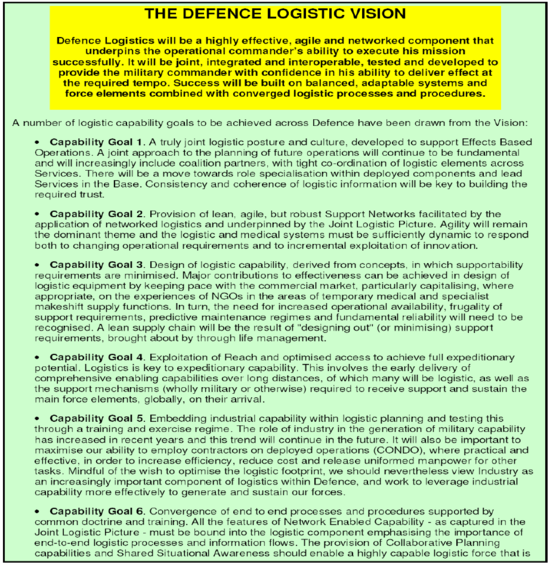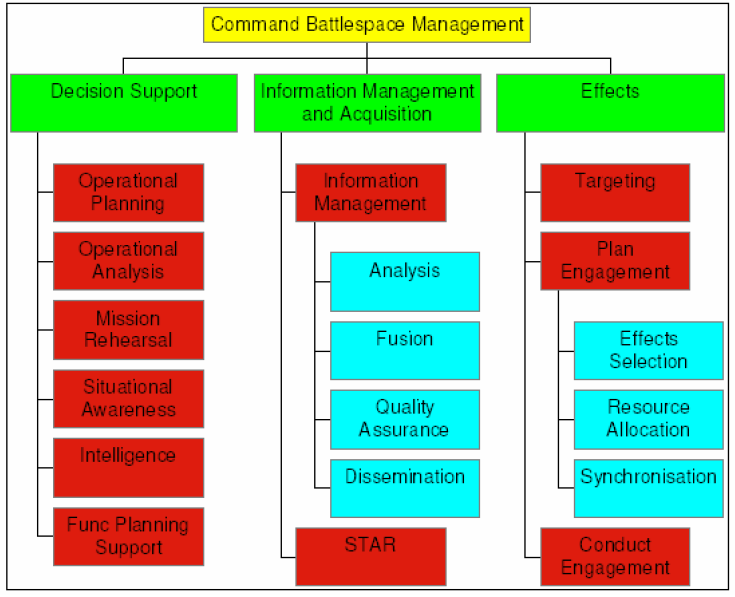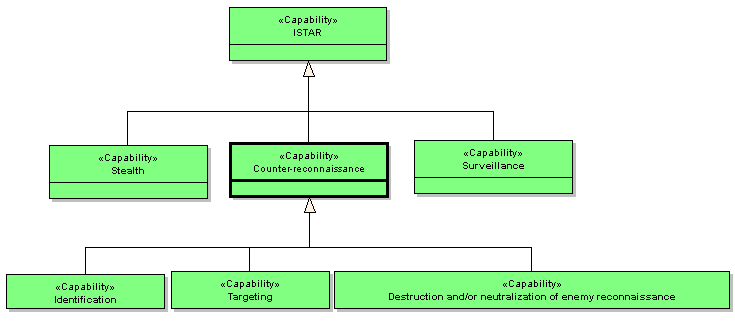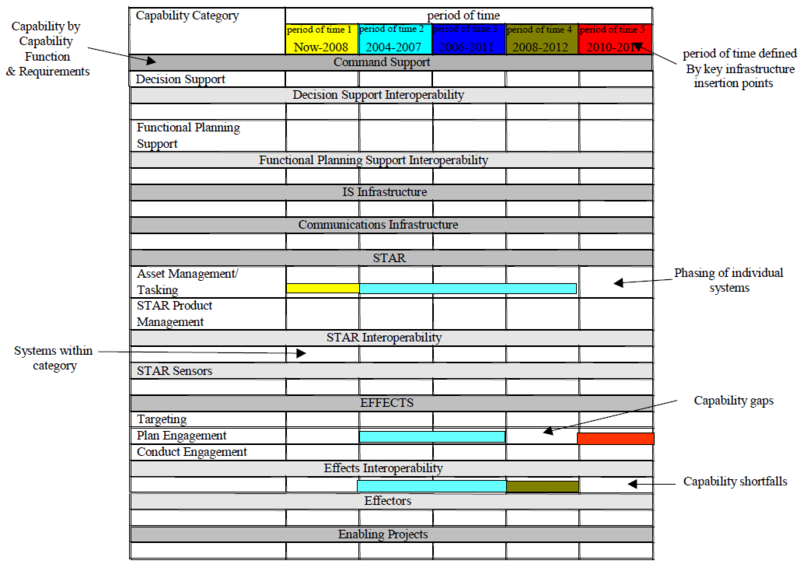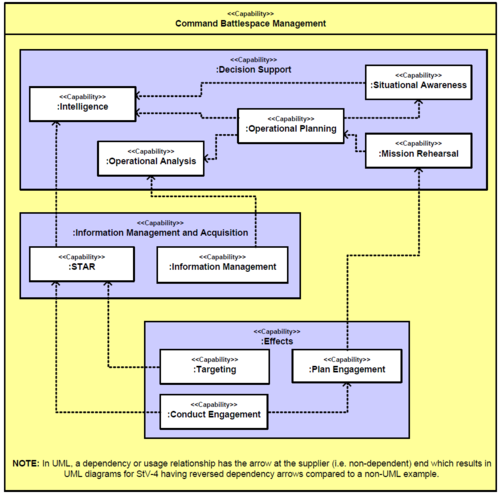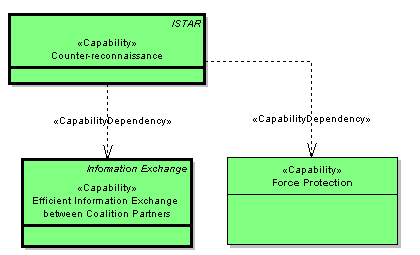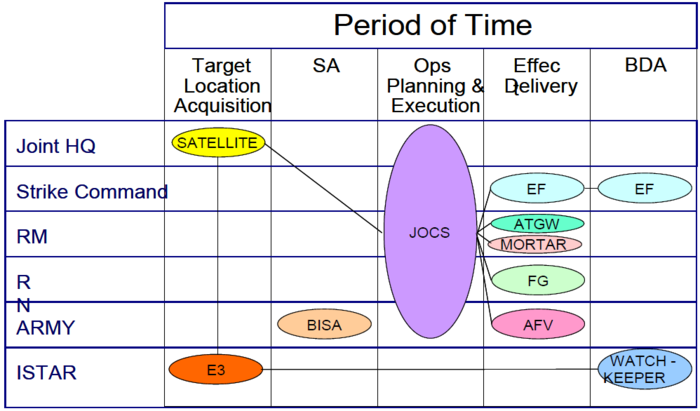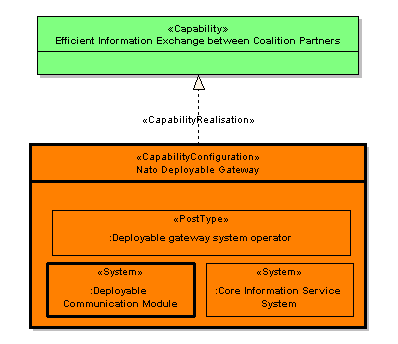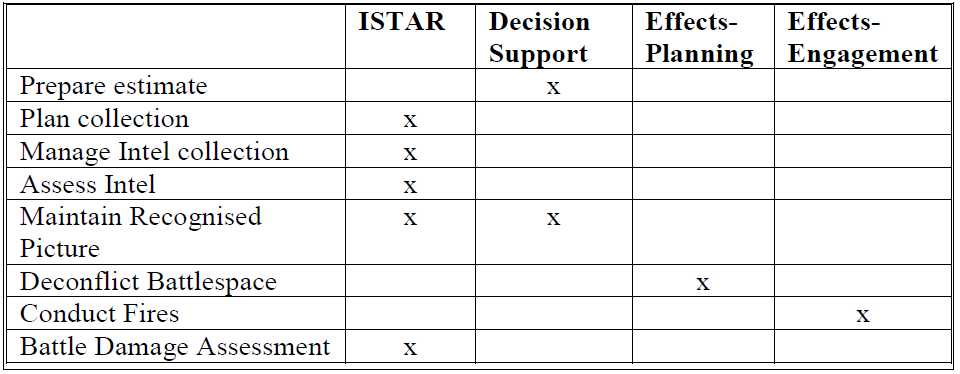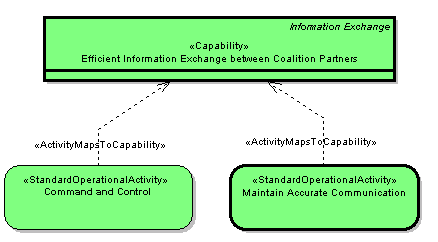Nato Architecture Framework (NAF) - 3.2 - NATO Capability View
<slideshow style="nobleprog" headingmark="。" incmark="…" scaled="false" font="Trebuchet MS" >
- title
- NAF - Part 3.2 - NATO Capability View
- author
- Bernard Szlachta (NobleProg Ltd)
</slideshow>
NCV, NATO Capability View
NCV-1, Capability Vision。
- Provides a strategic context for the capabilities described in the architecture
- Provides a high-level scope for the architecture which is more general than the scenario-based scope defined in an NOV-1
- Example
NCV-1, Capability Vision。
Definition
- An NCV-1 Capability Vision will begin by describing the high-level concept.
- This concept will then be further augmented by describing the high-level operational goals and strategy in military capability terms.
- As a general rule, the NCV-1 subview is not intended to specify the system requirements, or even the user requirements.
- Rather, it has the role of setting the scope for the architecture in terms of future or current military capability vision.
- The NCV-1 subview is high-level in nature and does not specify the success criteria for an architecture.
- NCV-2 provides metrics against each capability which may be used to measure success
NCV-2, Capability Taxonomy。
The Capability Taxonomy (NCV-2) subview provides a structured list of capabilities and sub-capabilities that are required within a capability area during a certain timeframe.
- Example
NCV-2, Capability Taxonomy。
Definition
- Is used to capture and organise the NATO capabilities required for the vision established in the Capability Vision subview (NCV-1) into a structured list.
- The structured list provided by the NCV-2 subview will be a comprehensive list of the capabilities that need to be delivered during a particular timeframe.
- The list is structured hierarchically, and each capability is, where necessary, subdivided into sub capabilities and/or functions, in order to provide clarity and the appropriate level of granularity required by subsequent processes in the capability management process.
- All terms used in the NCV-2 will be expressed only in non-implementation specific based terms - i.e. these terms are military capability based, not equipment focused.
- An NCV-2 product will be developed for each specified timeframe.
NCV-2, Capability Taxonomy。
Development Guidance
- The NCV-2 subview is used to support the Capability Audit process, providing a structured set of capabilities
- In addition it can be used as a source document for the development of high-level use cases and user requirements
- The NCV-2 subview has no mandated structure although the format selected must be able to support the representation of a structured/hierarchal list
- This structure may be delivered using textual, tabular or graphical methods
- The associated attributes and metrics for each capability function can either be included on the main NCV-2 subview, or in tabular format as an appendix if the inclusion of the attributes and metrics would over complicate the presentation of the subview
NCV-2, Capability Taxonomy。
Supporting NNEC Architecture Elements
For the development of this subview the modelling of the following NNEC architecture elements are essential:
- Operational objective
- Capability
NCV-2, Capability Taxonomy。
Running Example
Nato_Architecture_Framework_(NAF)_-_4.3_-_NATO_Meta_Model_-_NCV#NCV-2_Capability_taxonomy
NCV-3, Capability Phasing。
The Capability Phasing (NCV-3) subview provides a representation of the available military capability at different points in time or during specific timeframes.
- Example
NCV-3, Capability Phasing。
Definition
- is used to represent the planned or current availability of military capabilities at different points in time or during specific periods of time.
- is created by analyzing programmatic and deployment data to determine when system elements from NATO capability are to be deployed, upgraded and/or retired (this data may be provided in part by a Programme to Capability Mapping (NPV-2) subview).
- The systems identified are structured according to the required capabilities determined in the Capability Taxonomy (NCV-2) subview and the associated timeframes.
NCV-3, Capability Phasing。
Development Guidance
- NCV-3 products support the Capability Audit process and similar processes by providing a method to identify gaps or duplication in capability provisioning
- An NCV-3 product can be used to assist in the identification of capability gaps/shortfalls (no fielded capability to fulfil a particular capability function) or capability duplication/overlap (multiple fielded capabilities for a single capability function)
- Where a capability cannot be equated on a one-to-one mapping with a particular system, further analysis can be performed using the information provided in a Capability to Systems Deployment Mapping (NCV-5) product
- The NCV-3 subview is most easily presented in a tabular form – typically with the structured list of required capability functions (derived from the Capability Taxonomy (NCV-2) subview) running in one direction and timescale/timeframe running in the other
- At each row-column intersection, the system that delivers the capability within that time period (or Epoch) is displayed - if the availability of the capability spans multiple timeframes, then this is indicated by an elongated colour-coded 'bar'
- If there are no systems that satisfy the capability in that period of time then a blank space will be left
- It should be noted that many systems may satisfy a particular capability.
NCV-3, Capability Phasing。
Running Example
Supporting NNEC Architecture Elements
- Capability
- Service (Operational, Information and Application service)
Nato_Architecture_Framework_(NAF)_-_4.3_-_NATO_Meta_Model_-_NCV#NCV-3_Capability_phasing
NCV-4, Capability Dependencies。
- The Capability Dependencies (NCV-4) subview describes the dependencies between capabilities.
- It also defines logical groupings of capabilities.
- Example
NCV-4, Capability Dependencies。
Definition
- Shows the capabilities (or capability functions) which are of interest to the architecture
- It groups those capabilities into logical groupings (clusters), based on the need for those elements to be integrated.
- These clusters serve to inform the acquisition process and the Capability Phasing (NCV-3) subview
- The elements in an NCV-4 subview are not intended to represent individual systems or items of equipment – military capability may be satisfied by a group of systems, and an individual system can satisfy more than one capability – see Capability to Systems Deployment Mapping (NCV-5)
NCV-4, Capability Dependencies。
Development Guidance
- The NCV-4 subview is intended to provide a means of analyzing the dependencies between capabilities and between capability clusters
- The groupings of capabilities are logical, and one of the uses of the groupings is to guide acquisition – the dependencies and clusters may also suggest appropriate liaisons between acquisition projects in order to get the overall military capability
- The preferred approach for describing an NCV-4 subview is graphical, and there are a number of potential approaches
- Since the elements in an NCV-4 subview are essentially functional – i.e. they describe a required capability – the graphical notation is derived from the functional domain of systems engineering
- The widely used notation is a functional dependency diagram which shows how functions are clustered together and the relationships between the individual functions or clusters of functions
NCV-4, Capability Dependencies。
Running Example
Supporting NNEC Architecture Elements
- Capability
- Service (Operational, Information and Application service)
Nato_Architecture_Framework_(NAF)_-_4.3_-_NATO_Meta_Model_-_NCV#NCV-4_Capability_dependencies
NCV-5, Capability to Organisational Deployment Mapping。
Purpose
- Shows deployment of resources in general, and systems specifically, in NATO Operational Commands and the ability between those resources to satisfy the military capability for a particular timeframe (or Epoch).
- When appropriate and if necessary the subview can show how all relevant (existing and planned) NATO and National systems combine to provide a desired capability
NCV-5, Capability to Organisational Deployment Mapping。
Example
Please note that combinations of one or more of the mapping subviews NCV-5, NCV-6, NCV-7, NSOV-4, NSV-5 and NSV-12, can be used to construct (different variations of) a full mapping from capabilities to systems. The mappings form a line of reasoning through traceable linking of architecture elements from capabilities to systems
TODO: Get picture from MoDAF
NCV-5, Capability to Organisational Deployment Mapping。
Definition
- In order to conduct a comprehensive analysis of a capability over time, several NCV-5 subviews are created to represent the timeframes that are being analyzed
- Although the NCV-5 subviews are represented separately, NATO and National systems may exist in more than one subview
- The information used to create the NCV-5 is drawn from other NAF subviews (NCV-2, NCV-4, NOV-2, NSV-3, NPV-2, etc), and includes: capabilities, system connectivity, organisational structures, and programmatic information
NCV-5, Capability to Organisational Deployment Mapping。
Development Guidance
- The NCV-5 subview is used to support the capability management process
- Specific types of analysis that can be supported include:
- Capability redundancy/overlap/gap analysis;
- Identification of deployment level shortfalls;
- Identification of system connectivity issues;
- Requirements for system interoperability by organisation;
- Identification of system legacy issues; and
- Assessment of capability and system options
- The NCV-5 subview can be presented in a matrix with the appropriate organisational structure (such as described in NOV-4) represented by one axis, and the capabilities (as defined in NCV-2) by the other axis
- Graphical objects representing NATO and National systems are placed in the relevant positions relative to these axes
- Interconnection links connect systems that are dependent and/or have interaction with other systems
- Systems can be represented by multiple views corresponding to the timeframes for which those systems are in service
- The colour coding of a system remains unchanged across timeframes in order to identify the point at which a system entered service.
NCV-5, Capability to Organisational Deployment Mapping。
Running Example
Supporting NNEC Architecture Elements
- Actor
- Capability
- User
NCV-6, Capability to Operational Activities Mapping 。
- Describes the mapping between capability elements and the operational activities that those capabilities support
- Because military functions are seen as types of capabilities (as defined in NCV-2) NCV-6 also illustrates to what degree military functions are supported, i.e. whether operational activities do not, or only partially support military functions (so called 'gaps' or 'white spots'), or whether military functions are supported by more than one operational activity (addressing 'redundancy').
Example
NCV-6, Capability to Operational Activities Mapping 。
Definition
- An NCV-6 subview shows which capabilities may be utilized in support of specific operational activities
- The NCV-6 subview provides a bridge between capability analyses using NCVs and operational activities as defined by NOVs
- Specifically, it identifies how operational activities can be performed using various available capability elements.
Running Example
NCV-6, Capability to Operational Activities Mapping 。
Development Guidance
- The NCV-6 is best presented in matrix format, such as showing:
- operational activities on one axis
- capabilities (optionally including military functions) on the other
Supporting NNEC Architecture Elements
- Capability
- Process
NCV-7, Capability to Services。
Describes the mapping between capabilities and the services that these capabilities enable
Definition
- Shows which capabilities are required to be able to provide which services, or which services can be provided with a given set of capabilities.
- The mapping is an aggregation of other NAF subviews
- By combining NCV-6 (maps capabilities to operational activities) with NSOV-4 (maps operational activities to services), essentially a mapping between capabilities and services is obtained
NCV-7, Capability to Services。
Development Guidance
- The NCV-7 product is best presented as a matrix mapping capabilities to services, e.g. by showing:
- capabilities on one axis
- services on the other
- The capabilities included in the matrix must be consistent with identified capabilities in other subviews, most notably in NCV-2 Capability Taxonomy
- Optionally, Capability Dependencies, such as described in NCV-4, may be used to arrive at a high-level mapping matrix
- If instead, more detail is required, then a mapping between capability configurations and services may be more suited. However, this mapping is the purpose of NSV-12
- The services included in the matrix must be consistent with identified services in other subviews, most notably in NSOV-1 Service Taxonomy and NSOV-2 Service Definitions
- Please note that combinations of one or more of the mapping subviews NCV-5, NCV-6, NCV-7, NSOV-4, NSV-5 and NSV-12, can be used to construct (different variations of) a full mapping from capabilities to systems. The mappings form a line of reasoning through traceable linking of architecture elements from capabilities to systems.
NCV-7, Capability to Services。
Supporting NNEC Architecture Elements
- Capability
- Service (Operational, Information and Application service)
Nato_Architecture_Framework_(NAF)_-_4.3_-_NATO_Meta_Model_-_NCV#NCV-7_Capability_to_service_mapping
